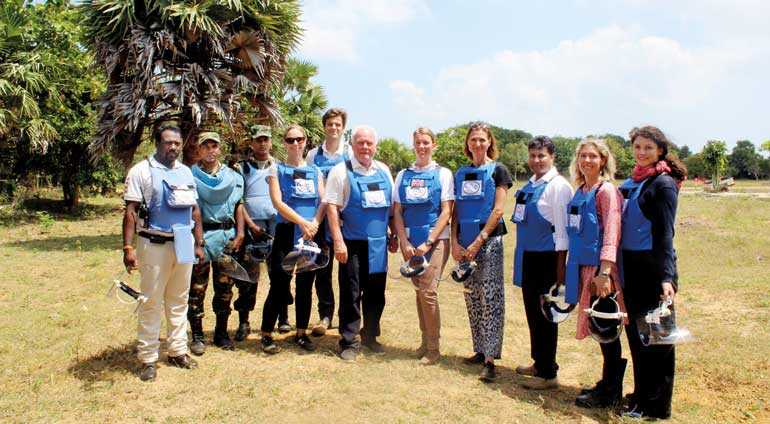Wednesday Feb 12, 2025
Wednesday Feb 12, 2025
Thursday, 4 April 2019 00:38 - - {{hitsCtrl.values.hits}}

On UN Mine Awareness Day
By Thorbjørn Gaustadsæther
Today, marks UN Mine Awareness Day. It provides an opportunity to focus on affected countries, such as Sri Lanka to recognise and take action to meet the needs of the affected people, and to assist them. Almost ten years after the end of the war, some areas in Sri Lanka are still contaminated with land mines and continue to be a threat to the lives of innocent civilians in those areas.
It was the harmful impact of landmines on civilians and their communities that provided the impetus for the Convention on the Prohibition of the Use, Stockpiling, Production and Transfer of Anti-Personnel Mines and on Their Destruction (Mine Ban Treaty). The Treaty was adopted in Oslo on 18 September 1997, and signed by 122 countries in Ottawa later that year. It currently has 164 states parties.
It is perhaps the most successful multilateral disarmament treaty in recent times. It is also an important tool to ensure the protection of civilians, both during a conflict and long after conflicts are over. Over the past 21 years, 51 million stockpiled mines have been destroyed, and vast areas have been successfully cleared and released to local communities all over the world.
We believe that today, the Mine Ban Treaty is more relevant than ever. Norway will continue to address the challenge of landmines in order to save lives around the world in the years to come, and we are committed to work with Sri Lanka to achieve its goal to be mine free
On 30 November 2018, Norway assumed the presidency of the Mine Ban Treaty. Norway has been supporting mine action for 25 years and is one of the top five donors to global mine action. Norway’s main focus is on humanitarian mine clearance to protect civilians. This means that our funding is channelled through humanitarian organisations.
Norway is currently funding mine action in more than 18 countries and areas. Last year, Norway provided NOK 325 million (approximately $ 38 million) for mine clearance efforts in these 18 countries. To take this action forward, we look forward to welcoming states parties, observers and civil society to the Fourth Review Conference to be held in Oslo on 25-29 November.
Last December, at the 17th Meeting of the State Parties to the Mine Ban Convention, the Government of Sri Lanka reiterated its commitment to creating a mine-free Sri Lanka by 2020. Sri Lanka has also shown regional and global leadership by assuming the presidency of the Convention on Cluster Munitions.
The international community commended Sri Lanka’s Progress Report on Demining, which was tabled at the meeting. Soon after the end of the war in 2009, approximately 1,302 Sq.km of land in Sri Lanka’s North and East was identified as landmine contaminated areas. With the help of national and international organisations, Sri Lanka has carried out extensive mine clearance activities.
According to the Government of Sri Lanka, during the last decade, 1,276 Sq.km of lands have been cleared of mines and released for human settlement. By December 2018, 94 % of the mined areas had been cleared. Therefore, at present it is believed that only 26 Sq.km extent of land is yet to be cleared. Furthermore, it is noteworthy to mention that Sri Lanka recently launched its National Mine Action Strategy 2016-2020.
Norway is pleased to assist Sri Lanka in completing this important work and to achieve its goal to be mine free by 2020. Last month, the Norwegian State Secretary, Marianne Hagen, visited Sri Lanka and announced Norway’s contribution of approximately NOK 60 million (approximately $ 7 million) for demining in Sri Lanka over the next three years. The funding will be channelled through Mines Advisory Group (MAG) and HALO Trust, which are two mine clearance operators that have been working in Sri Lanka for a long time.
Globally, we do not know how many lives have been saved or how much development has been achieved because land has been cleared and released. But, what we do know is that each of the 51 million mines around the world that have been destroyed has potentially saved a life or a limb. Further, Norway believes demining is an important aspect for peace, reconciliation and transitional justice and allows displaced to people to permanently resettle.
Across the world, 58 states and three other areas are still affected by landmines (22 of these are not parties to the Mine Ban Treaty). In many affected states, landmine contamination is low or modest, and with the right approach and commitment, it is possible to complete clearance within months or a few years. Far more experience, technological advances and vastly improved methodologies are available to the mine action sector than was the case when the Mine Ban Treaty was adopted 21 years ago.
It is also important to recognise that a mine-free world does not mean a world without landmine victims and survivors. Survivors will continue to need access to services, education and employment in their communities. In Sri Lanka, it is heartening to note that the Government and other parties involved have provided the victims with emergency assistance covering medical care, artificial limbs, and psychosocial support. It is important that the organisations that work on mine risk education coordinate with each other and with vulnerable communities, refugees and IDPs, in order to prevent new casualties.
We believe that today, the Mine Ban Treaty is more relevant than ever. Norway will continue to address the challenge of landmines in order to save lives around the world in the years to come, and we are committed to work with Sri Lanka to achieve its goal to be mine free.
(The writer is the Ambassador of Norway to Sri Lanka and Maldives.)
Discover Kapruka, the leading online shopping platform in Sri Lanka, where you can conveniently send Gifts and Flowers to your loved ones for any event including Valentine ’s Day. Explore a wide range of popular Shopping Categories on Kapruka, including Toys, Groceries, Electronics, Birthday Cakes, Fruits, Chocolates, Flower Bouquets, Clothing, Watches, Lingerie, Gift Sets and Jewellery. Also if you’re interested in selling with Kapruka, Partner Central by Kapruka is the best solution to start with. Moreover, through Kapruka Global Shop, you can also enjoy the convenience of purchasing products from renowned platforms like Amazon and eBay and have them delivered to Sri Lanka.
Discover Kapruka, the leading online shopping platform in Sri Lanka, where you can conveniently send Gifts and Flowers to your loved ones for any event including Valentine ’s Day. Explore a wide range of popular Shopping Categories on Kapruka, including Toys, Groceries, Electronics, Birthday Cakes, Fruits, Chocolates, Flower Bouquets, Clothing, Watches, Lingerie, Gift Sets and Jewellery. Also if you’re interested in selling with Kapruka, Partner Central by Kapruka is the best solution to start with. Moreover, through Kapruka Global Shop, you can also enjoy the convenience of purchasing products from renowned platforms like Amazon and eBay and have them delivered to Sri Lanka.